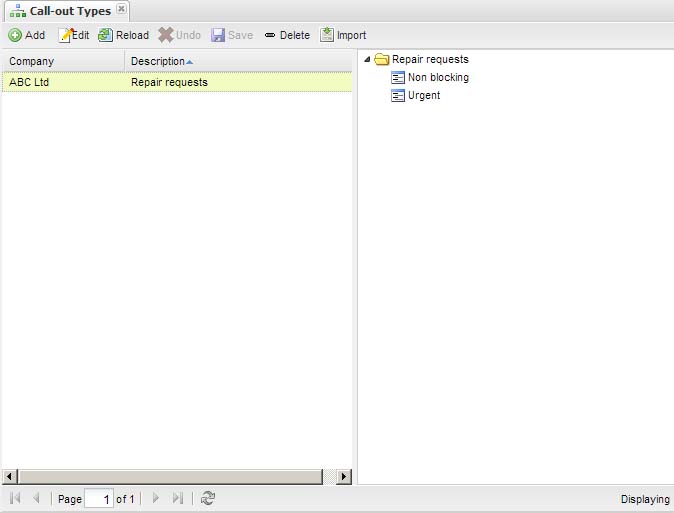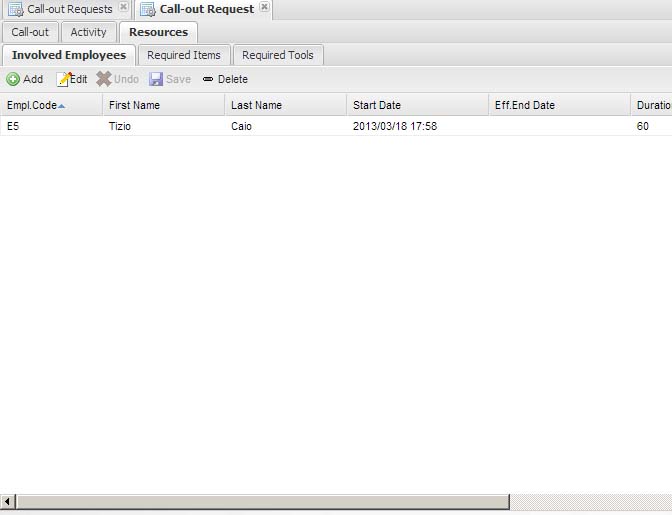| Home | SourceForge.net | More documentation |
| Project Page |
| Documentation |
| Download |
| Installation Info |
| Tickets |
| Public forums |
Activities, Call-out requests and Customer Relationship Management
This application was developed in a few months thanks to Openswing capabilities: this development framework allows to create RIAs with a GUI having very complex contents with low development time.
For companies providing services, JAllInOneWeb allows the definition of services and resources and the control of all activities. These activities can be billable or not, for internal usage or external customers, and can be monitored in several ways.
For internal usage, there are some services provided to all company employees:
- An agenda where each employee can graphically manage appointments
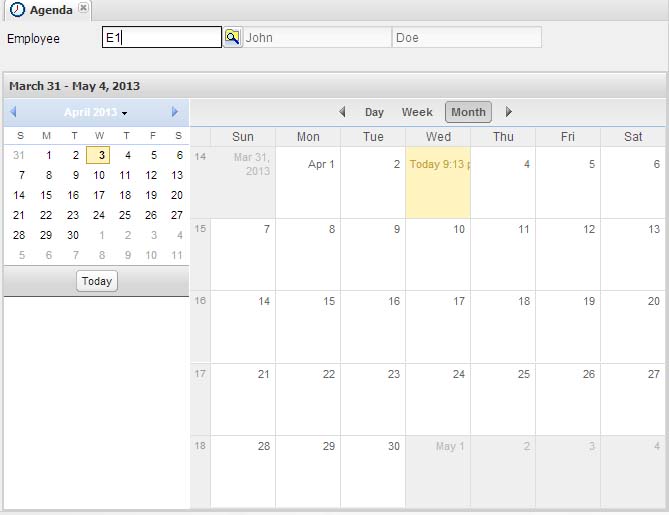
It is possible to quickly show day appointment by selecting a day of the month and per several filter criteria, such as: employee, from date, activity type, subject involved in the activity.
An new activity can be defined by simply drag an area in the agenda: this action will open a detail window to define the activity; by double clicking an existing activity it is possible to manage the selected activity through the same detail window.
This window allows to define the activity type and, according to that selected activity type, other information specific of the activity. An activity has an activity state that can be changed to lock activity changes when it has been closed.
For each activity it is possible to define also a list of resource to schedule, in terms of employees, instruments and items needed for the activity.
Other data defined in this detail window are:
- Start activity date and time
- Estimated end activity date and time
- End activity date and time
- Due date
- Activity duration
- Estimated activity duration
- Priority
- Activity description
- Activity place
- Subject involved
- Note
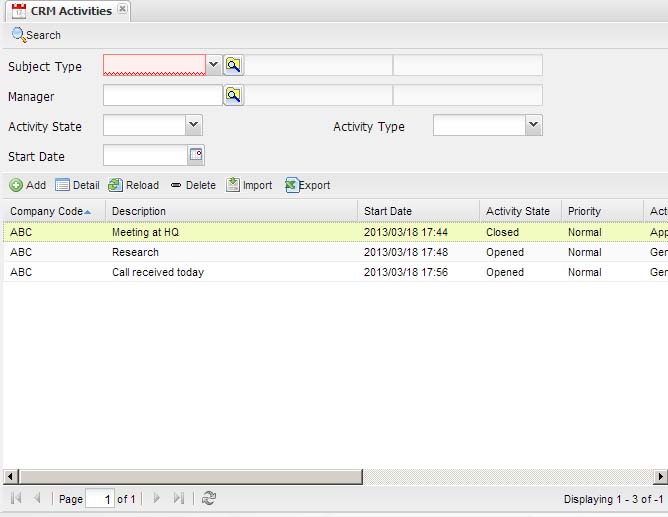
- A scheduled activity functionality where defining an activity to schedule; in this form it is possibile to define resources needed to perform the activity: human resources (employees filtered by duty), machineries or items; it is based on the same detailed window described above.
The list of scheduled activities provides a filter panel to reduce the list of activities to show, according to several settings.
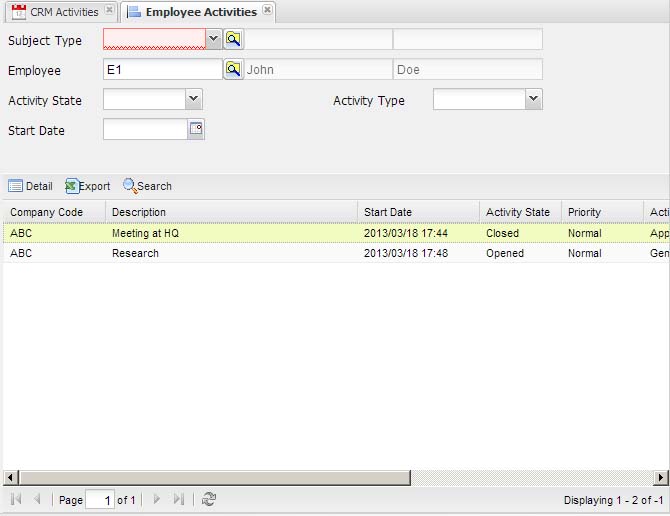
In general, all these features can be used to define external activities too: call-outs management is provided by JAllInOne, by defining:
• call out types (as a hierarchy of call-out types)
• call-out definition (in terms of machineries, items and duties required to perform the activity binded to the call-out request)
|
In “Call-out types” functionality it is possible to define the hierarchy of a specific call-out type; in the “Call-outs” functionality are reported all call-out definitions.
A call-out definition requires to specify a call-out code and description; moreover a list of resource types must be defined; these are resources specifically required to accomplish a call-out request, created starting from a call-out definition.
There are 3 types of supported resources:
• Employees; in call-out definition there are not defined directly employees but instead duties that specific employees must match
• Instruments required during the call-out execution (e.g. machineries, tools, etc)
• Items required during the call-out execution (e.g. spare parts)
|
• Call-out request management, by defining call-out type, request information and resources needed; call-out request confirmation creates activities for allocated employees, automatically showed in the agenda, scheduled activity functionality and gantt diagram.
When creating a new call-out request, a detail window is showed to guide the user on the request definition and resources scheduling. That window is based on several sub-folders that are automatically enabled when the user saves the previous folder, from left to right, as in a wizard.
This is the iter to follow:
• the first task is the subject identification, through the search of the contact/customer name and surname or corporate name that is currently requesting a call-out; if the contact/customer is not yet defined, it can be created in this moment;
• after subject identification, the second folder becomes enabled; in “Call-Out Detail” sub-folder the user can define request information (request date, due date, etc) and select the call-out type and inherits from that call-out type the requested resource types;
• after call-out type selection, the third folder becomes enabled. In this folder a new scheduled activity is being created;
• finally the user can schedule resources involved with the new scheduled activity, by selecting resources from the available resources list, filtered by the resource type (inherited from the call-out type); employees can be assigned to this activity by selecting them from a lookup or from a Gantt diagram.
A call-out request generates an activity and related scheduled resources; these can be viewed in the other activity windows, such as Gantts, Scheduled Activities and Agenda. This activity can then be managed as any other scheduled activity.
|
In case of repair requests in after sale scenario, the call out detail window optionally allows to specify a product that the customer has purchased in the past and to use in order to choose spare parts related to that product in the call-out activity resources folder. The item lookup in call-out detail folder shows all items defined in the system; by selecting the "Show purchased items" check-box, the item lookup will only shows items that was sold to the customer in the past; item lookup also shows the sale date.
Within the buttons bar of items grid in "Activity resources" folder, it is available a "Show spare parts catalogue" button, enabled when a product has been selected in callout detail: when pressing that button, the spare parts catalogue will be showed and the list of product's spare parts is automatically proposed; when double clicking a spare part, that item will be reported in the items grid: this feature will speed up the spare parts retrieval and selection related to a product repair.
|
Moreover, it is possible to create a sale invoice from the closed activities defined in a call out request.
All these features globally provide a simple form of CRM: JAllInOneWeb groups all these functionalities in a single “CRM” folder:
- Contacts and contacts hierarchies management
- Customers management
- CRM activities, where a user can define activities and search them through a powerful filter panel.
